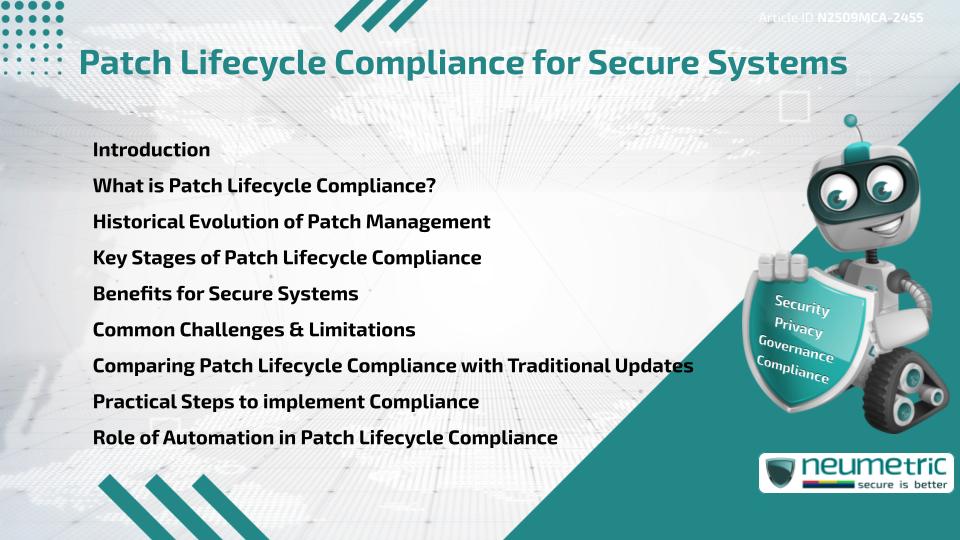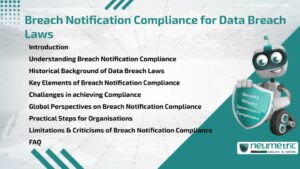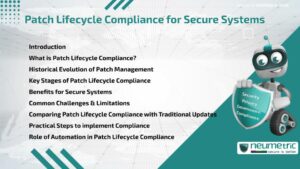Table of Contents
ToggleIntroduction
Patch Lifecycle Compliance is the process of managing software & system updates in a structured, consistent & policy-driven manner. It ensures that Vulnerabilities are addressed quickly, reducing the Risks of Cyberattacks & System Failures. Secure systems depend on timely patching to maintain Integrity, protect Sensitive Data & comply with Regulatory Standards. Without Compliance, even the most advanced security tools can be undermined by unpatched weaknesses.
What is Patch Lifecycle Compliance?
Patch Lifecycle Compliance refers to aligning the management of patches with organisational Policies, Regulatory requirements & Industry Standards. It involves more than just installing updates; it ensures every patch is tracked, tested, applied & documented across its lifecycle.
For example, when a Vendor releases a critical Security Patch, Compliance means assessing its relevance, testing it for compatibility, applying it promptly & verifying its effectiveness, all within a defined timeframe.
Historical Evolution of Patch Management
In the early days of computing, patching was informal, often handled manually by system administrators. As systems grew complex, manual patching became impractical & error-prone. High-profile Security Incidents, such as Worms & Ransomware outbreaks, highlighted the dangers of delayed updates.
Regulatory frameworks & Industry Standards, such as ISO/IEC 27001 & NIST guidelines, later formalised Patch Lifecycle Compliance. This evolution transformed patching from an ad-hoc task into a structured discipline central to secure systems.
Key Stages of Patch Lifecycle Compliance
A robust Patch Lifecycle Compliance process follows several key stages:
- Identification: Monitoring for Vendor releases & Vulnerability alerts.
- Assessment: Determining the relevance & criticality of patches.
- Testing: Ensuring patches do not disrupt system operations.
- Deployment: Rolling out patches to affected systems in a controlled manner.
- Verification: Confirming that patches are applied successfully.
- Documentation: Keeping records for Audits & Compliance checks.
Each stage ensures a balance between operational stability & security requirements.
Benefits for Secure Systems
Organisations that practice Patch Lifecycle Compliance gain important benefits:
- Reduced exposure to Cyberattacks
- Greater system stability & reliability
- Compliance with Regulatory & Industry Standards
- Increased confidence among Customers & Stakeholders
- Improved ability to respond to emerging Threats
By embedding patching into security strategies, organisations strengthen their systems against known Vulnerabilities.
Common Challenges & Limitations
Despite its importance, Patch Lifecycle Compliance is not without obstacles:
- Resource Constraints: Limited staff or budget to manage patches effectively
- Complex Environments: Large systems with multiple platforms & dependencies
- Downtime Concerns: Fear of patch-related disruptions delays implementation
- Shadow IT: Unmanaged systems or applications that bypass patching processes
- Rapid Threat Landscape: New Vulnerabilities emerge faster than patches can be applied
These limitations highlight the need for structured Governance & Automation.
Comparing Patch Lifecycle Compliance with Traditional Updates
Traditional updates often focus on installing patches whenever convenient, without clear processes or accountability. In contrast, Patch Lifecycle Compliance enforces a structured approach.
It can be compared to Healthcare: treating illnesses as they arise (traditional updates) is reactive, while scheduled check-ups & preventive care (Patch Lifecycle Compliance) ensure long-term health.
Practical Steps to implement Compliance
To achieve Patch Lifecycle Compliance, organisations should:
- Create Patch Management Policies aligned with Industry Standards.
- Maintain an updated inventory of all systems & applications.
- Automate patch monitoring & deployment where possible.
- Test patches in controlled environments before rollout.
- Establish timelines for applying critical versus non-critical patches.
- Train IT staff on Compliance responsibilities.
- Conduct regular Audits to verify adherence.
These steps provide a Framework for sustainable & effective patching practices.
Role of Automation in Patch Lifecycle Compliance
Automation is essential for managing Patch Lifecycle Compliance in modern environments. Tools can:
- Continuously scan for missing patches
- Prioritise updates based on severity
- Schedule deployments to minimise downtime
- Provide real-time Compliance dashboards
- Generate Audit-ready reports
By reducing human error & accelerating response times, automation ensures secure systems remain resilient against Threats.
Takeaways
- Ensures structured, policy-driven patching
- Reduces Vulnerabilities & cyber Risks
- Maintains stability of secure systems
- Supports Regulatory & Industry Compliance
- Automation strengthens Patch Management efficiency
FAQ
What is Patch Lifecycle Compliance?
It is the structured process of managing, applying & documenting patches to maintain secure & compliant systems.
Why is Patch Lifecycle Compliance important?
It reduces Risks of cyberattacks, ensures Regulatory Compliance & helps maintain system stability.
What are the stages of Patch Lifecycle Compliance?
The stages include Identification, Assessment, Testing, Deployment, Verification & Documentation.
What challenges do organisations face?
Challenges include resource limitations, system complexity, downtime concerns & emerging Vulnerabilities.
How is Patch Lifecycle Compliance different from traditional updates?
Traditional updates are reactive, while Patch Lifecycle Compliance is proactive, structured & auditable.
Can automation help with Patch Lifecycle Compliance?
Yes, automation improves efficiency, reduces errors & ensures timely application of patches.
How often should systems be patched?
Critical patches should be applied as soon as possible, while less urgent patches should follow defined organisational timelines.
Need help for Security, Privacy, Governance & VAPT?
Neumetric provides organisations the necessary help to achieve their Cybersecurity, Compliance, Governance, Privacy, Certifications & Pentesting needs.
Organisations & Businesses, specifically those which provide SaaS & AI Solutions in the Fintech, BFSI & other regulated sectors, usually need a Cybersecurity Partner for meeting & maintaining the ongoing Security & Privacy needs & requirements of their Enterprise Clients & Privacy conscious Customers.
SOC 2, ISO 27001, ISO 42001, NIST, HIPAA, HECVAT, EU GDPR are some of the Frameworks that are served by Fusion – a SaaS, multimodular, multitenant, centralised, automated, Cybersecurity & Compliance Management system.
Neumetric also provides Expert Services for technical security which covers VAPT for Web Applications, APIs, iOS & Android Mobile Apps, Security Testing for AWS & other Cloud Environments & Cloud Infrastructure & other similar scopes.
Reach out to us by Email or filling out the Contact Form…





